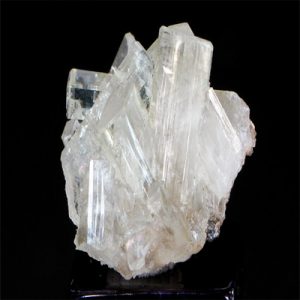Thaumasite: Gemstones Information
Thaumasite is a rare and intriguing mineral that belongs to the carbonate mineral group. Named after the Greek word “thaumazein,” meaning “to be astonished,” thaumasite indeed captivates with its unique crystal structure, properties, and occurrences. Here, we delve into the fascinating world of thaumasite, exploring its discovery, characteristics, occurrences, and significance.
Discovery and Characteristics:
Thaumasite was first discovered in 1878 in the Harz Mountains of Germany by mineralogist August Breithaupt. It was initially mistaken for another mineral, but its distinctive crystal habits and properties soon distinguished it as a new mineral species. Thaumasite typically forms as transparent to translucent prismatic crystals with a white, gray, or pale yellow coloration. It exhibits a vitreous to pearly luster and a Mohs hardness of around 3 to 3.5, making it relatively soft compared to many other minerals.
Crystal Structure:
Thaumasite crystallizes in the trigonal crystal system and belongs to the space group \( R\bar{3}c \). Its crystal structure consists of interconnected tetrahedral and octahedral units, with carbonate ions occupying the center of the structure. Thaumasite crystals often exhibit pseudohexagonal forms due to their trigonal symmetry. Under certain conditions, thaumasite can undergo structural modifications, resulting in variations in its physical and optical properties.
Occurrences:
Thaumasite is primarily found in association with calcium-rich minerals in hydrothermal veins, limestone cavities, and metamorphic rocks. Significant occurrences of thaumasite have been reported in countries such as Germany, Italy, Canada, South Africa, the United States, and Russia. It commonly forms as secondary mineral deposits in environments where calcium carbonate-rich rocks are altered by hydrothermal fluids containing sulfate ions. Thaumasite can also occur as a weathering product in cementitious materials, particularly in concrete exposed to sulfate-rich groundwater.
Significance and Applications:
Thaumasite is primarily valued for its scientific significance and as a curiosity among mineral collectors. Its intricate crystal structure and unusual occurrences make it a subject of interest for mineralogists, geologists, and researchers studying mineral formation processes, crystal chemistry, and geological environments. However, thaumasite does not have significant industrial or commercial applications due to its relative rarity and limited occurrence in nature.
Environmental Implications:
Thaumasite has garnered attention for its potential impact on concrete structures and infrastructure. In the presence of sulfate ions and certain environmental conditions, thaumasite can form within concrete, leading to a phenomenon known as thaumasite sulfate attack (TSA). TSA occurs when thaumasite crystals precipitate within the concrete matrix, causing swelling, cracking, and deterioration of the material. This can compromise the structural integrity of buildings, bridges, and other concrete structures, posing challenges for construction and engineering projects in sulfate-rich environments.
Conclusion:
Thaumasite, with its distinctive crystal structure and occurrences, offers valuable insights into mineralogy, geology, and environmental science. While it may not be as well-known or commercially significant as other minerals, thaumasite’s role in geological processes and its potential impact on concrete infrastructure underscore the importance of understanding its properties and behaviors. As researchers continue to investigate thaumasite and its interactions with the environment, we gain a deeper appreciation for the complexities of the natural world and the dynamic interplay between minerals and human activities.





